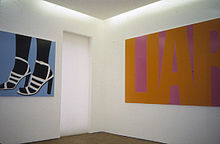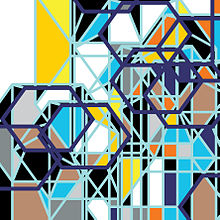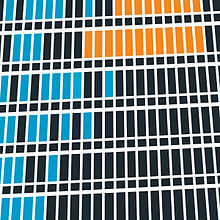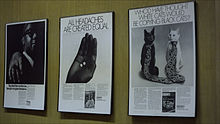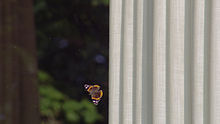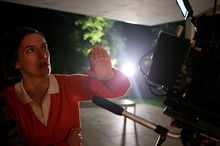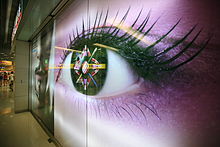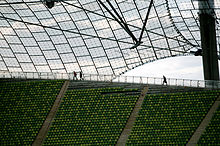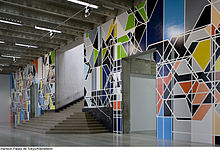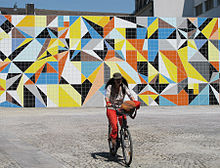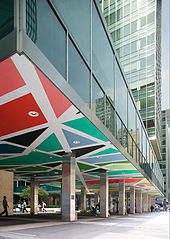- Sarah Morris
-
For the singer or the actress, see Sarah Jane Morris (disambiguation).
Sarah Morris 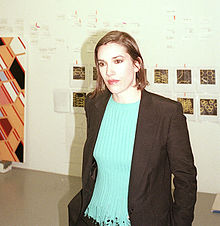
Born 1967
Sevenoaks, EnglandNationality American, British Field Contemporary Art Training Jesus College, Cambridge Sarah Morris (born 1967, Sevenoaks,[1] Kent), is a British-born American artist.
Contents
Education and exhibitions
Morris double majored in Semiotics and Political Philosophy at Brown University, graduating magna cum laude. She studied at Jesus College, Cambridge University, associated with Professor Raymond Williams, when Professor Stephen Heath was situated and did her final year in the Social and Political Sciences [SPS] department. She attended the Whitney Museum of American Art Independent Study Program from 1989-90.[2]
Since the mid-1990s, Sarah Morris has been making abstract paintings and films. The confluence of her studies in film theory and political philosophy has greatly informed her practice. Morris’s work derives from close inspection of architectural details combined with a critical sensitivity to the psychology of a city, its politics, its key protagonists as well as its citizens. Morris began her career making graphic paintings that adapted the dramatic, emotive language used in newspaper and tabloids. She was interested in the idea of emptying out and playing with the narrative forms of specific articles found in The New York Times and the New York Post. Her 1995 painting Guilty from that series, inspired the name of Dakis Joannou’s yacht designed by Jeff Koons.[3]
Her first studio was situated in Times Square and its location was a key influence on her practice. The visual and aural density of the site, as well as the prevalence of midtown corporate culture, provided the impetus for her interest in the architecture of power and what Nicolas Bourriaud called an “art of amplification.”[4]
Morris curated several shows, including a series titled "Closeup" in the early 1990s, held in the Times Square studio location with Rita Ackermann, Mariko Mori, Bernadette Corporation and a group show of Sam Taylor-Wood, Gary Hume, and Jane and Louise Wilson, amongst others.[5] In 1997, Morris curated a group show titled "Hospital", after the lyrics of the Modern Lovers' song, at Max Hetzler Gallery, Berlin which included work by Darren Almond, Liam Gillick, Richard Hamilton, Jeff Koons, Jorge Pardo, Richard Phillips, and Jane and Louise Wilson.[6] In 1999-2000, she was a Berlin Prize Fellow at the American Academy in Berlin.[7] She received the Joan Mitchell Foundation Painting Award in 2001.
Morris has exhibited widely — at Museum für Moderne Kunst, Frankfurt (2009), Museo d’Arte Moderna, Bologna (2009), Fondation Beyeler, Riehan/Basel (2008), Städtische Galerie im Lenbachhaus, Munich (2008), Museum Boijmans van Beuningen, Rotterdam (2006), Moderna Museet, Stockholm (2005), Palais de Tokyo, Paris (2005), Kestner Gesellschaft, Hannover (2005), Kunstforeningen, Copenhagen (2004), Museum of Contemporary Art, North Miami (2002), Hirshhorn Museum, Washington, D.C. (2002), and Nationalgalerie im Hamburger Bahnhof, Berlin (2001), among others.
Artistic practice
Sarah Morris’s work is concerned with decoding the built environment. Focusing on the urban experience, she explores techniques of communication – the relationships between signs and symbols and their referents in the physical world. As an exploration of the elaborate conversation between architecture and power, Morris’s paintings and films complement and connect to one another.[8] Generating a constant back and forth play between the two media, this duality is a key element of her practice. Morris describes her films as ‘condensed manifestos’ for the paintings – they are a compendium of images and situations that could provide the visual source and psychological complexity from which the paintings begin and abstractly evolve.[9]
Morris named her studio “Parallax” both for the Hollywood classic, The Parallax View, and for the idea of parallel production. Generally the term parallax refers to an optical phenomenon whereby the position or direction of an object appears to shift due to a change in the position of the observer. This apparent change is relational, and it always involves a new line of sight. In her studio activity Morris is involved with the parallel production of paintings and films, each with its own set of related concerns, allowing for different narratives and interpretations to emerge. Indecipherability and the idea of not being able to perceive depth also go along with the idea of parallax.[10]
Morris’s paintings explore the codes and power structures of architecture and cultural symbols. Her work focused initially on the vocabulary and signs belonging to media and advertising, before gradually turning to other signs, those of the city and urban planning. Through her paintings, Morris manages to disembody the cities she explores in her films, removing them from all narrative or figurative content.[11] Drawing from graphic and industrial design, Morris typically works with household gloss paint, focusing on surface and the condensation of space and culture. Joanna Burton writes, “There is no clear foreground, no distinct background, only surface: places where the eye is left more easily to roam, spots where it is hard to untangle the gaze.”[12] The regularity of the painted surface, that suggests no depth whatsoever, becomes analogous to the mirror-like surfaces of the buildings Morris depicts in series such as “Midtown” and “Los Angeles”.[13]
Morris’s paintings have often been seen in the lineage of Pop, post-painterly, and Minimal art of the 1960s yet, she has been able to free herself nonetheless from her influences to develop a singular identity that lies at the crossroads of Pop, Conceptual art and geometric abstraction. As one critic describes, “Stella resonates here, too, this time as the painter of concentric squares and mitered mazes, generating complexity and dynamic spatiality out of unremitting flatness.” [14] Referred to as, “Mondrians seen through a politically inflected kaleidescope”,[15] Morris intentionally leaves the criticality of her work open-ended. Mark Rappolt writes that her work, “focuses on the surface of things and that even when it delves deeper its only to look at the ways in which that surface is prepared (scrubbed, vacuumed, made up, rehearsed).”[16] Her paintings have been described as “quite literally caught between what they say and what they do.”[17] Along the same vein, Morris was asked by The editor of British Vogue, Alexandra Shulman in 2000 to think of a project using Kate Moss. In response, Morris proposed to shoot and design the cover of British Vogue in May 2000.[18] Similar to Richard Hamilton's design of the Beatles White Album, she was interested in intervening in the surface and packaging of the magazine. The image was a riff on the Roxy Music album, The Atlantic Years.
In her films, Morris uses a conceptual strategy of duality, which examine both the surface of a city – its architecture and geography – as well as its ‘interior’: the psychology of its inhabitants and key players. Morris investigates how metropolises turn their outward appearances into self-referential cosmoses.[19] As Martin Hebert explained in a description of her film “Los Angeles”, “This is Los Angeles as it likes to present itself: a string of ideas corralled into hectic but workable geometry. A town, as Christopher Isherwood once put it, which is like an advertisement for itself.”[20] Morris assesses what today’s architectural façades and urban structures, cities and nations, might conceal. Often, these non-narrative fictional analyses result in conspiratorial studies of power, the structures of control, and global socio-political networks.[21]
Morris employs very different kinds of cinematography – from documentary recording to apparently narrative scenarios – which work as a method of visual distraction, a way of exploring the urban environment, and more particularly its issues of social power and representation.[22] In her films, “Midtown” (New York), 1998, “AM/PM” (Las Vegas), 1999, “Capital” (Washington D.C.), 2000, “Miami”, 2002, “Los Angeles”, 2004, and "Beijing", 2008, Morris exploits the boundaries of documentary and fiction, creating both a memory and most importantly, Morris’s fantasy of the city, constructing multiple fragmentary situations for the viewer. The films track the urban plan, architecture, and various sites of production.[23] The fragments of daily life, both extraordinary and ordinary, point to an overall connectivity; a network of social systems which extends all the way to the viewer. As Morris states, “this whole network…is much larger than us and there is no external position, there is no objective position.”
Strategies of communication remain at the heart of Morris’s work. She is interested in ‘the most simplified, coded way to have a conversation with the viewer’.[24] The intricately designed works construct a virtual architecture and a monopoly-like indexing, and co-opting of, existing power structures, be it corporate, governmental, or seemingly individual.[25] Her paintings and films illuminate, and are illuminated by, the political debates of the past decades they address, over power and economics, critical urbanity, or inclusion and exclusion.[26] Her work pinpoints that moment of moral crosschecking that occurs when we contemplate our role in relationship to the roles offered us by society. It pinpoints a moment of moral conversion when we ambiguously accept or reject or acquiesce to what’s generally available for us as citizens.[27]
Films
- Chicago (68 minutes,[28] 2011)
Chicago investigates the psychology, architecture and aesthetic of the American city made all the more resonant in the wake of President Barack Obama’s administration.
When Mies van der Rohe emigrated to American in 1938, with the help of Philip Johnson, and was established as the Head of Architecture at the Illinois Institute of Technology, he not only created an image of America, but the reality of the contemporary American society. Continuing to play with duality, Morris’s Chicago is tandem with “Points on a Line”, shifting the lens to a panorama of an American city in transition. In Chicago, Morris reveals a new cityscape by tracking its modern architecture, the seemingly dead printed world of publishing headquartered there, as well as its industrial role. A century after the publication of Upton Sinclair’s “The Jungle”, the issues shift from food production to consumption and a struggling printing, publishing and advertising world.
A sequence of images and cinematic situations set to an original musical score by the artist Liam Gillick, range from John Hancock Center, Vienna Beef factory, Playboy Headquarters, Fermilab – home of the nation’s largest energy particle accelerator, Mayor Richard Daley, Ebony headquarters, and Alinea.
Chicago captures the varied layers of a complex metropolis without verbal commentary or narration. It exploits the boundaries of documentary and fiction, and collides the city’s everyday moments with issues of social power and representation.
- Points on a Line (36 minutes,[28] 2010)
Points on a Line is an exploration of Farnsworth House (Plano, Illinois) and Philip Johnson's Glass House, in New Canaan, Connecticut. The film documents a shared desire to build structures that might change the way we think about a house, a form and a context. These two buildings were the result of shared ideas and collective desire. But they also complicate ideas of the copy and the original and the chronologies of Modernism.
The two buildings demonstrate a legacy of focus upon details and surface – inside and outside. By carefully documenting the daily maintenance of these two buildings and lingering over the precise placement of the structures in space and of objects within each structure, we are presented with a clear view of places that have gone beyond their initial use and become the intersection of a dialogue that was both personal and professional.[29]
Morris's deployment of cinematic codes in relation to architectural precision produces images that go beyond a record of functionality or the streamlining of needs. These are places that remain elusive despite their openness – structures that are open vessels where we search for markers of the corporate aesthetic to come and the legal wrangles that marked the struggle to complete and maintain them. Buildings that require constant representation and new documentation in order to recode and understand what came before and what came next. Obtaining complete unrestricted access for each location of the film, Morris has woven together art, architecture and corporate image production with flowers, the behavior of bees and the patterns of butterflies - window washing, cooking, power-broking and collecting.
Morris filmed at both sites over the course of several months, among other locations including The Four Seasons Restaurants, the Seagram Building, Mies van der Rohe’s infamous Lake Shore Drive, and Chicago’s Newberry Library. Morris utilizes The Four Seasons, a place that Philip Johnson practically used as his personal office, as the meeting point between the two architects. The restaurant remains a site of projection and desire – active as a site of negotiation and display. Morris’s film is both a record of preservation of two structures and a document of power plays that left a mark in the pragmatic idealism of the late modern period.
The soundtrack, composed by the artist Liam Gillick, lends an atmospheric progression to the film.
- Beijing (86 minutes,[30] 2008)
Morris’s feature-length film Beijing, 2008, focuses on the city at a pivotal moment in history, suffused with the exhilaration, spectacle, and paranoia of the Olympic moment.
Beijing is a paradoxical city: at once historical and futuristic, Maoist and hypercapitalist. It is undergoing unprecedented change and reinvention. Morris's Beijing captures the variances within this change, both large and small, from Sunday morning T'ai chi at the Temple of Heaven to the monumental Bird's Nest on the Olympic Green; from the family-run newsstand to the President of China, Hu Jintao. Morris's version of cinema vérité relays the schisms of the city through its architecture, infrastructure, and inhabitants, as well as addressing broader questions of celebrity, political power, and, the effects of change.
As with her previous films, architecture and infrastructure are not the only "characters" in Beijing: former President Bush,[disambiguation needed
 ] actor Jackie Chan, classical pop sensation Lang Lang, Dr. Henry Kissinger, Olympian Michael Phelps, director Zhang Yimou, and architects Rem Koolhaas, Jacques Herzog, Pierre de Meuron, and Norman Foster,[disambiguation needed
] actor Jackie Chan, classical pop sensation Lang Lang, Dr. Henry Kissinger, Olympian Michael Phelps, director Zhang Yimou, and architects Rem Koolhaas, Jacques Herzog, Pierre de Meuron, and Norman Foster,[disambiguation needed  ] among others, make appearances in the film.
] among others, make appearances in the film.- 1972 (38 minutes, 2008)
In 1972 (2008), Morris used Dr. Georg Sieber as a central character. Dr. Sieber was the head psychologist of the Olympic Police during the 1972 Munich Olympics. Sieber was present on Connolly Street on the morning of September 5, 1972, when members of the terror group Black September attacked and took hostage the members of the visiting Israeli Olympic Team known as the Munich massacre. Later that morning he resigned from his position. Sieber was hired by the International Olympic Committee and Munich Police to project possible scenarios that would jeopardize the safety of the Olympic Games and prepare the security training that they would require.
One of the scenarios written by Sieber was an almost exact prognosis of what was to play out in reality. Continuing her investigation of the concept of the “peripheral” character, it becomes clear that Sieber had proposed an alternative method of navigating the situation that could have led to a different outcome. It is the failure of this planning and its political motivations that captivates Morris. The film begins with Dr. Sieber in the back of a BMW 7 series stating: “Especially in this case, there won’t be a historical truth in the sense of a reality. Historical truth is only the sum of subjective perceptions, interpretations and thoughts, which can be slightly proven by comparing dates and comparing statements and documents. But the real truth remains an ideal, a dream, something, which isn’t real....”
 Film Poster for Robert Towne, 2006
Film Poster for Robert Towne, 2006
- Robert Towne (35 minutes, 2006)
Robert Towne is a portrait of the legendary Hollywood script-writer, director, producer and actor who was best known for his screenplays, including Chinatown [1974], Shampoo [1975], and Personal Best [1982] and as a script doctor behind films such as Bonnie and Clyde [1967], The Parallax View [1974], and The Godfather [1972]. His works are marked by their moral ambivalence, realistic dialogue and ruthless dissection of cruel or corrupt systems of social authority.
In the film, an interview with the subject covers topics ranging from his Academy Award-winning screenplay for “Chinatown” (1974), the role of authorship, his relationship with colleagues such as Robert Evans, Warren Beatty, Pauline Kael, and the reoccurring themes in his film work - conspiracy, paranoia, corruption, and power.
In Morris's Robert Towne, the lens shifts from a wide panoramic view of a city to an intimate portrait of an individual citizen within that city and a model of a progressive work methodology. Morris describes him as an “elliptical figure” whose career exemplifies a certain characteristic mode of working in the film industry, marked by collaboration, shared or changing roles. The film examines a figure who parallel to Morris’s own work, couples modern America’s economic and cultural success with a dark underbelly of conspiracies and individual power-relations. Morris’s paintings and films posits that the city itself is series of conspiracies.
The film interestingly parallels Morris’ later film, Beijing, and introduces Personal Best, after which Morris titled her exhibition at Air de Paris in 2011.
- Los Angeles (26 minutes,[31] 2004)
Los Angeles explores an industry fuelled by fantasy and examines the trenchant relationship between studio, producer, director and talent. The film investigates the psychology, architecture and aesthetic of the American city. It reveals a new cityscape of Los Angeles by tracking its de-centered plan, complex architecture, and most importantly its crucial role as a center of film production. “Los Angeles” posits the city as a hyper-narrative within a very distinct duration of time. Here the city is caught at its most ebullient and narcissistic moment: the week leading up to the Oscars.
A sequence of images and cinematic situations set to an original musical score, range from the rehearsals and pre-production moments of the Academy Awards to a John Lautner house, Brad Pitt on the set of Mr. & Mrs. Smith at Twentieth Century Fox, the final taping of Hollywood Squares at CBS, the Bonaventure Hotel, Pat Kingsley at work, I.M. Pei’s Creative Artist’s Agency, Mulholland Drive, the Department of Water and Power, and the Vanity Fair party. Los Angeles captures the varied layers of a complex metropolis without verbal commentary or narration.
On the occasion of Los Angeles, Morris created a film poster in collaboration with M/M Paris, the design partnership consisting of Mathias Augustyniak (b. 1967, Cavaillon) and Michael Amzalag (b. 1968, Paris). Together, they have created film posters for many of Morris's other films, which serve as conceptual markers for the films, allowing for a visual presence both in the city and the exhibition space. The poster for the film Robert Towne was inspired by Towne's description of the director as "an anarchist who wants to the control the fantasy world". Relating also the role of the artist, the statement could also describe the act and struggle of directing in general.
- Miami (28 minutes, 2002)
Operating between a documentary, the biography of a city, and a form of non-narrative fiction, Miami shifts between sites of production, leisure and work. The Coca-Cola bottling plant, the Grand Prix[disambiguation needed
 ] and the hotels of Morris Lapidus are just a few of the places that interweave in a sequence of urban images that combine towards a new ultra-vision of a place.
] and the hotels of Morris Lapidus are just a few of the places that interweave in a sequence of urban images that combine towards a new ultra-vision of a place.- Capital (18 minutes, 2000)
Capital was shot in Washington during the final days of the Clinton administration and continues Morris's investigation of the way we decode and therefore begin to understand the built world around us. It is a record of now unimaginable access to the centers of power.
First exhibited at the National Gallery in Berlin (Hamburger Bahnhof), Capital[disambiguation needed
 ] draws a complex and layered city portrait. The Mall, the White House Press Office, the World Bank, uniformed members of the Secret Service, the Presidential motorcade, the Watergate Complex, the Kennedy Center, the J. Edgar Hoover Building, The Pentagon, the daily activities of the President and an overall consideration of the city form a sequence of reflection points for her series of paintings. While her earlier paintings from New York and Las Vegas offered a new examination of the codes and structures of our urban environment, these new works introduce a revised mapping of power, desire, urbanism and design.
] draws a complex and layered city portrait. The Mall, the White House Press Office, the World Bank, uniformed members of the Secret Service, the Presidential motorcade, the Watergate Complex, the Kennedy Center, the J. Edgar Hoover Building, The Pentagon, the daily activities of the President and an overall consideration of the city form a sequence of reflection points for her series of paintings. While her earlier paintings from New York and Las Vegas offered a new examination of the codes and structures of our urban environment, these new works introduce a revised mapping of power, desire, urbanism and design.- AM/PM (13 minutes, 1999)
Taking its title from an all-day/all-night convenience store, AM/PM examines the Las Vegas Strip, portraying the disorienting world of corporate hotels and casinos which utilize and redefine the spectacle in relation to architecture. AM/PM posits the concept of distraction itself as a strategy and the city as a conspiracy, which manipulates and directs the visitor.
- Midtown (9 minutes, 1998)
Shot in New York during a single day, Midtown brings together sequences which show the streets of midtown Manhattan - combining the anonymity of the crowded side-walks with the power of the buildings that frame the everyday movements of the city. Almost a catalogue of peripheral actions, it explores the narrative possibilities inherent in the simplest actions, and the typical activity of the street. The fragmented narrative emphasizes the structure of modern life as well creating a space in which the viewer takes an extremely active role.
Site-specific artworks
Morris has developed site-specific projects for institutions internationally since 1999. In July 2010, she realized "Hornet", a permanent artwork which opened that summer at K20, celebrating the re-opening of Kunstsammlung Nordrhein-Westfalen Museum in Düsseldorf. The artwork covers an entire wall of the interior courtyard, measuring almost 2,000 square feet (190 m2). Hovering between abstraction and representation, the artwork calls forth the lack of boundaries between graphic design, aesthetics, and the commercial, while at the same time playing with the idea of cross-pollination in general, particularly in the arts. Morris selected the name "Hornet" because it is both futuristic and utilitarian, as well as playful and sometimes dangerous. In 2009 Morris produced two large scale site specific wall paintings on the occasion of her museum solo shows at the Museum für Moderne Kunst, Frankfurt (2009) and Museo d’Arte Moderna, Bologna (2009). "Chimera", at the Museum für Moderne Kunst, Frankfurt intersects both the unique post-modern architecture of the Hans Hollein museum across two floors and the exhibit itself. Morris's largest site-specific installation to date was "Robert Towne", commissioned by the Public Art Fund. The 20,000-square-foot (1,900 m2) artwork expanded across the ceiling of the plaza and the lobby of the historic Lever House building in Manhattan, the first building to have a public plaza, built in 1951. Morris was attracted to the complicated, 'unresolved' nature of the public plaza and its 'Jacques Tati element'.[32] Morris has also realized site specific artworks at the Gulating Court House in Bergen, Norway (2011), Gateway School of Science, New York (2010), Fondation Beyeler, Riehen/Basel (2008), Public Art Fund/Lever House (2006), Key Biscayne, Miami (2005), Palais de Tokyo (2005), UBS Zurich Headquarters (2001) and ICA Boston[disambiguation needed
 ] (1999).
] (1999).Public collections
Work by Morris is held in the public collections of various museums, including the Solomon R. Guggenheim Museum, New York, New York;[33] Centre Pompidou, Paris, France; The Museum of Modern Art, New York, New York; San Francisco Museum of Modern Art, San Francisco, California; Stadtische Galerie im Lenbachhaus, Munich, Germany; Museum fur Moderne Kunst, Frankfurt, Germany; Neue Nationalgalerie im Hamburger Bahnhof Berlin, Germany; Tate Modern, London, England; Kunstmuseum Wolfsburg, Wolfsburg, Germany; Miami Art Museum, Miami; Museum of Contemporary Art of San Diego, California; Stedelijk Museum, Amsterdam, Netherlands; Musee d’Art Moderne de la Ville de Paris, France; the Victoria and Albert Museum, London, England; Albright-Knox Art Gallery, Buffalo; Galerie fur Zeitgenossiche Kunst, Leipzig; Yale Center for British Art, New Haven; and Dallas Museum of Art, Dallas.[34].
Allegation of copyright infringement
On April 29, 2011, a group of original origami artists from around the world, led by Robert J. Lang filed a complaint—in the Northern District of California—against Morris for copyright infringement of their original works. The artists allege that Morris produced a number of paintings by simply coloring their origami crease patterns.[35] The allegation claims that as many as 25 of Morris' work were simply colorized version of the crease patterns. It is not entirely clear, however, that crease patterns are protected by copyright, as it is possible that the courts may consider them useful works rather than artistic ones.
References
- ^ Guggenheim Collection Online: Sarah Morris Bio.
- ^ Gaby Wood, "Cinéma vérité", The Observer, 23 May 2004.
- ^ "Dakis Joannou's Guilty Pleasure". Dakis Joannou's Guilty Pleasure. Nowness. http://www.nowness.com/day/2010/3/8/434/dakis-joannou-s-guilty-pleasure. Retrieved 2011-06-29.
- ^ Bourriaud, Nicolas (1996). Sarah Morris Sugar. Paris: Galerie Philippe Rizo.
- ^ Guillen, Mauricio, "Treading in Fashion", 'Not in Fashion', Museum fur Moderne Kunst, pp. 58
- ^ Pierre Alexandre de Looz, "Living the Bauhaus", Artinfo, 15 Dec 2009.
- ^ "Sarah Morris: Artist, New York". American Academy in Berlin. http://www.americanacademy.de/home/fellows/detailansicht/person//fellow/sarah_morris/239/detail/. Retrieved 15 December 2010.
- ^ Archer, Michael (May 2009). "Sarah Morris". Artforum.
- ^ Theirry, Somers (2010). "Sarah Morris, Psychology of the Future". 200% 4: 131–150.
- ^ Rabinowitz, Cay Sophie (2005). Los Angeles. Cologne: Galerie Aurel Scheibler. pp. 7–9.
- ^ Nicolas Bourriaud; Jérôme Sans. "Sarah Morris". 'Endeavor [Los Angeles]'. Palais de Tokyo. http://www.palaisdetokyo.com/fr/presse/communiques/morris/dpmorrisen.pdf. Retrieved 5 August 2011.
- ^ Joanna, Burton (2008). Lesser Panda. London: White Cube. pp. 12.
- ^ Jan Winkelmann (1999). Modern Worlds. Oxford: Museum of Moder Art Oxford.
- ^ Archer, Michael (November 2008). "Sarah Morris: White Cube". Artforum: p. 362.
- ^ Wood, Gaby (23 May 2004). The Observer Magazine: pp. 22–27.
- ^ Mark Rappolt (May 2009). Art Review: pp. 70–77.
- ^ Joanna Burton (2008). Lesser Panda. London: White Cube. pp. 13.
- ^ Morris, Sarah. "Vogue Magazine Archive". Vogue. http://www.vogue.co.uk/magazine/archive/issue/2000/May/View/Cover. Retrieved 5 August 2011.
- ^ Anke Kempkes, "[1]," Frieze', October, 2001
- ^ Morris, Sarah (2004). Bar Nothing. 2004: White Cube. pp. 31–34.
- ^ Morris, Sarah; Andrea Viliani (2009). Beijing. Cologne: Walther Koenig.
- ^ Woods, Scott, "Diagram of a Headache", Adam and Eve, March/April/May 2009.
- ^ Art Daily, "Sarah Morris Black Beetle on View", Art Daily, 31 May 2008.
- ^ White Cube, "[2]," White Cube, March, 1996
- ^ "[3]," Aurel Scheibler'
- ^ Morris, Sarah (2008) (in English/German). 1972. Köln: Verlag der Buchhandlung Walther König. pp. 6–7.
- ^ Morris, Sarah (2004). Bar Nothing. London: White Cube. pp. 3–7.
- ^ a b Modern Views
- ^ Susanne Harpfer, [4], Philip Johnson Glass House, 21 Sept 2010
- ^ The Barbican screening
- ^ The Aldrich Contemporary Art Museum
- ^ "Wonderful Towne! Lever House Hosts Homage to Screenwriter", The Observer, 16 Sept 2006.
- ^ [5]
- ^ Gallery Hyundai, "Sarah Morris: Clips, Knots and 1972", p.60
- ^ Unattributed "These Origami Artists Just Won't Fold", JD Supra, retrieved, May 6, 2011.
Literature
- Chinnery, Colin, Anthony Lane, and Andrea Phillips. Sarah Morris: Beijing (Museo d’Arte Moderna di Boogna, Museum fur Moderne Kunst Frankfurt, Witte de With, Rotterdam, Walther Konig, Cologne 2009)
- Burton, Johanna, Diederichsen, Diedrich, de Looz, Pierre-Alexandre. Sarah Morris: Lesser Panda (White Cube Gallery, London 2008)
- Thierry Somers, "Sarah Morris, Psychology of the Future." 200% Number 4 2010; 131-150
- Sarah Morris, "A Few Observations on Taste or Advertisements for Myself." Texte Zur Kunst, September 2009; 71-74
- Erhard Metz, "Sarah Morris: Gemini Dressage", Feuilleton Frankfurt, June 3, 2009
- Michael Archer. "Sarah Morris", Artforum, May 2009, p. 170
- Mark Rappolt, "Sarah Morris", Art Review, May 2009, pp. 70–7
- Hans Ulrich Obrist, "Sarah Morris", Adam & Eve, March/April/May 2009, pp. 78–91
- Cay Sophie Rabinowitz, "Sarah Morris: An interview." Art in America December 2008: 146-149
- Michael Archer, "Sarah Morris, White Cube." ArtForum November 2008: 362
- Eric Banks, "Seeing Red", Men's Vogue, August 2008, pp. 114–119
- Adrian Searle, "Dazzled by the Rings", The Guardian, July 30, 2008
- Christopher Turner, "Beijing City Symphony", Modern Painters, July/August 2008, pp. 56–59
- Rem Koolhaas, Hans Ulrich Obrist, Christina Bechtler, "Sarah Morris: Rings, Origami, Beijing", Arena Homme+, Summer/Autumn 2008: 258-68
- Holger Liebs, "Lage 26 warnight gefragt", Suddeutsche Zeitung 26/27, April 2008; 18
- Philippe Parreno, "All Hawaii Entrees/Lunar Reggae", Irish Museum of Modern Art, Charta, 2006: 126
- Kristin M. Jones, "Sarah Morris", Frieze, November 2008:163
- "Sarah Morris Lever House, Public Art Fund." artforum.com, September 22, 2006.
- Toni Schlesinger, "Wonderful Towne! Lever House Hosts Homage to Screenwriter", The New York Observer, September 18, 2006
- Marcus Verhagen, "Nomadism", Art Monthly October 2006
- Tanja Widmann, "To Offer You Something", Texte Zur Kunst, September 2006, pp. 248–251
- Art Now (25th Anniversary Edition), edited by Uta Grosenick, Burkhard Riemschneider, Taschen, pp. 196–199, 2005
- Ezra Petronio and Stephanie Moisdon, Bar Nothing by Sarah Morris, Self Service, Issue No.21, Fall/Winter 2004, pp. 302–315
- Gaby Wood, "Cinéma Vérité", The Observer Magazine, May 23, 2004: 22
External links
- Radial Matrix Flickr
- China 2008 And Other Power Plays According to SARAH MORRIS - 032c Magazine
- Sarah Morris, Built to Last - W Magazine
- White Cube: Sarah Morris
- Friedrich Petzel Gallery: Sarah Morris
- Air de Paris: Sarah Morris
- Galerie Meyer Kainer: Sarah Morris
- Public Art Fund: Sarah Morris
- Vernissage TV: Sarah Morris
- Vimeo: Sarah Morris
- Flickr Hive Mind
- Cinéma vérité - The Guardian
- Dazzled by the rings - The Guardian
- Sarah Morris interview with Cay Sophie Rabinowitz, Art in America
- Sarah Morris: Living the Bauhaus
- Patrick McMullan: Sarah Morris
- A statement by Robert J. Lang
- The complaint by Robert Lang et al against Sarah Morris, Case No. C11-01366-EMC
- Exhibit A in the complaint against Sarah Morris
Categories:- American artists
- Brown University alumni
- Living people
- 1967 births
- People from Sevenoaks
- People from Kent
- Women painters
Wikimedia Foundation. 2010.


